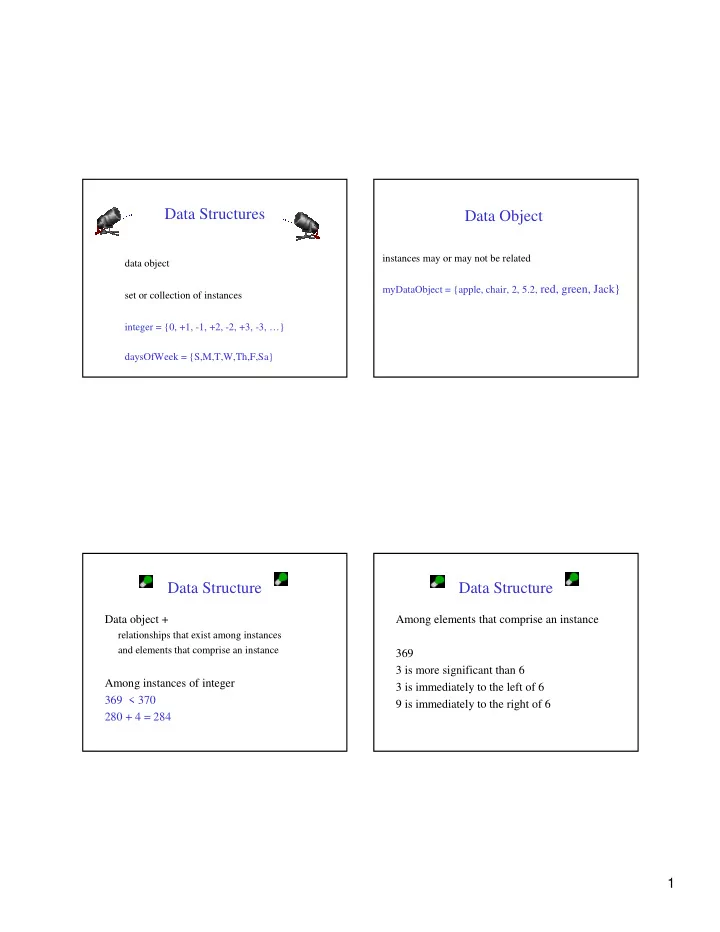

Data Structures Data Object instances may or may not be related data object myDataObject = {apple, chair, 2, 5.2, red, green, Jack} set or collection of instances integer = {0, +1, -1, +2, -2, +3, -3, …} daysOfWeek = {S,M,T,W,Th,F,Sa} Data Structure Data Structure Data object + Among elements that comprise an instance relationships that exist among instances and elements that comprise an instance 369 3 is more significant than 6 Among instances of integer 3 is immediately to the left of 6 369 < 370 9 is immediately to the right of 6 280 + 4 = 284 1
Data Structure Linear (or Ordered) Lists The relationships are usually specified by instances are of the form specifying operations on one or more (e 0 , e 1 , e 2 , …, e n-1 ) instances. where e i denotes a list element add, subtract, predecessor, multiply n >= 0 is finite list size is n Linear Lists Linear List Examples/Instances Students in COP3530 = L = (e 0 , e 1 , e 2 , e 3 , …, e n-1 ) (Jack, Jill, Abe, Henry, Mary, …, Judy) relationships Exams in COP3530 = e 0 is the zero’th (or front) element (exam1, exam2, exam3) e n-1 is the last element Days of Week = (S, M, T, W, Th, F, Sa) e i immediately precedes e i+1 Months = (Jan, Feb, Mar, Apr, …, Nov, Dec) 2
Linear List Operations—get(theIndex) Linear List Operations—size() get element with given index determine list size L = (a,b,c,d,e) get(0) = a L = (a,b,c,d,e) get(2) = c get(4) = e size = 5 get(-1) = error get(9) = error Linear List Operations— Linear List Operations— indexOf(theElement) remove(theIndex) remove and return element with given determine the index of an element index L = (a,b,d,b,a) L = (a,b,c,d,e,f,g) indexOf(d) = 2 remove(2) returns c indexOf(a) = 0 and L becomes (a,b,d,e,f,g) indexOf(z) = -1 index of d,e,f, and g decrease by 1 3
Linear List Operations— Linear List Operations— add(theIndex, theElement) remove(theIndex) add an element so that the new element has a specified index remove and return element with given index L = (a,b,c,d,e,f,g) L = (a,b,c,d,e,f,g) add(0,h) => L = (h,a,b,c,d,e,f,g) remove(-1) => error index of a,b,c,d,e,f, and g increase by 1 remove(20) => error Linear List Operations— add(theIndex, theElement) Data Structure Specification � Language independent L = (a,b,c,d,e,f,g) � Abstract Data Type � Java add(2,h) => L = (a,b,h,c,d,e,f,g) � Interface index of c,d,e,f, and g increase by 1 � Abstract Class add(10,h) => error add(-6,h) => error 4
Linear List Abstract Data Type Linear List as Java Interface AbstractDataType LinearList { An interface may include constants instances ordered finite collections of zero or more elements and abstract methods (i.e., methods operations isEmpty() : return true iff the list is empty, false otherwise for which no implementation is size(): return the list size (i.e., number of elements in the list) provided). get(index) : return the index th element of the list indexO f(x) : return the index of the first occurrence of x in the list, return -1 if x is not in the list remove(index) : remove and return the index th element, elements with higher index have their index reduced by 1 add(theIndex, x) : insert x as the index th element, elements with theIndex >= index have their index increased by 1 output() : output the list elements from left to right } Linear List as Java Interface Implementing An Interface public interface LinearList { public boolean isEmpty(); public class ArrayLinearList implements LinearList public int size(); { public Object get(int index); // code for all LinearList methods must be provided here public int indexOf(Object elem); } public Object remove(int index); public void add(int index, Object obj); public String toString(); } 5
Linear List As An Abstract Class Linear List As Java Abstract Class public abstract class LinearListAsAbstractClass { An abstract class may include public abstract boolean isEmpty(); constants, variables, abstract public abstract int size(); methods, and nonabstract methods. public abstract Object get(int index); public abstract int indexOf(Object theElement); public abstract Object remove(int index); public abstract void add(int index, Object theElement); public abstract String toString(); } Extending A Java Class Implementing Many Interfaces public class ArrayLinearList public class MyInteger implements Operable, Zero, extends LinearListAsAbstractClass CloneableObject { { // code for all abstract classes must come here // code for all methods of Operable, Zero, } // and CloneableObject must be provided } 6
Extending Many Classes Data Structures In Text NOT PERMITTED IN JAVA All but 1 of our data structures are specified as Java interfaces. A Java class may implement as many interfaces as it wants but can extend at most Exception is Graph in Chapter 17. 1 class. Java specifies all of its data structures as interfaces. java.util.List 7
Recommend
More recommend